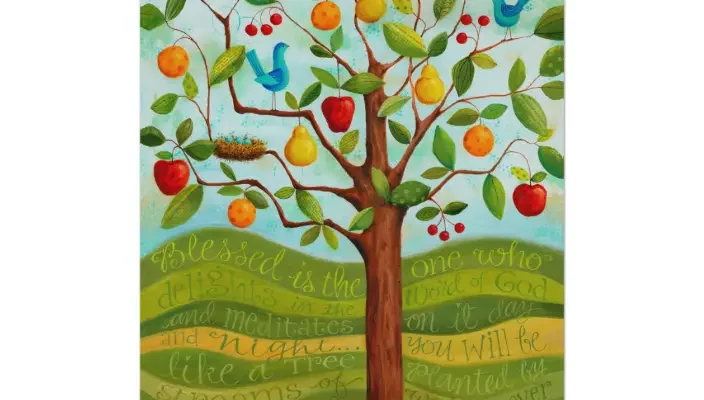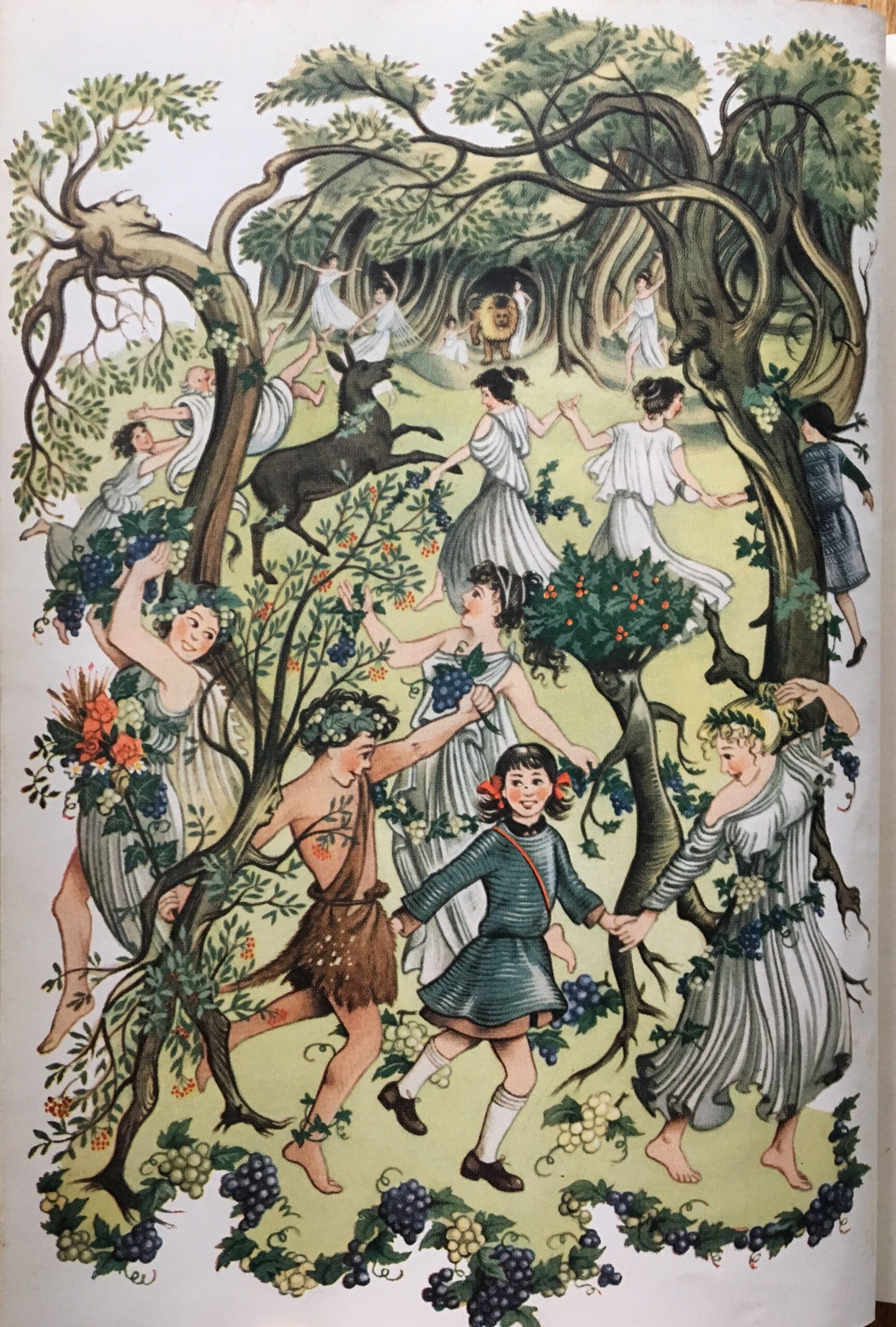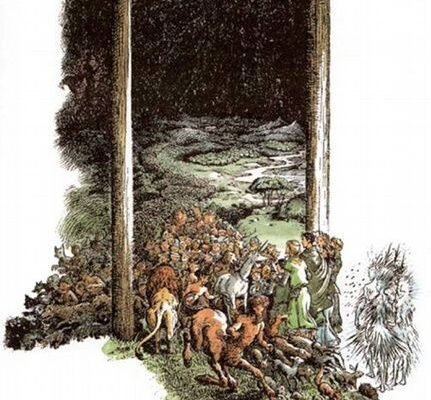Read or Listen to this blogcast
In C. S. Lewis’s The Chronicles of Narnia‘s The Silver Chair, we meet some new characters, like Puddlegum the Marsh-wiggle and a new human character, Jill Pole. The unlikely pair of a sensible girl and the Narnia-born marsh dweller end up taking part in a rescue expedition, along with Eustace, to search for the lost Prince of Narnia. They do find the Prince after a harrowing series of adventures when they encounter an evil queen of Narnia, the Lady of the Underworld. She is immediately recognizable as the villain. For one, she is dressed in a serpentine green dress and unsurprisingly becomes a large serpent herself when she must be menacing.
There is a longstanding tradition in mythical stories to represent female villains as serpentine enchantresses. The anthropomorphized woman, especially with snake-like affiliations can certainly be traced back to the biblical narrative in Genesis. One of the earliest stories of creation ties the fate of the serpent to the first woman. In Genesis, the first created woman speaks with a serpent. Her mate, a male, is nearby but does not involve himself with the conversation, either because he is unaware or uninterested. Regardless, it is this interaction that leads the woman to eat fruit from a tree that God has warned them about, saying if they ate from this tree they would then know death. The cunning serpent preyed on the innocence or is it ignorance(?) of the woman and told her the rest of the story. They would not only know death, but they would become like the gods, even like the very Godself that warned them about the tree in the first place, the very Godself who created the tree and placed it there. This story has caused much speculation about the relationship between the serpent and the woman and has led to theological speculation about a relationship between woman and evil. The image is further perpetuated in the Hebrew Bible book of Proverbs, especially Chapters 8-9, where Lady Wisdom, who is the picture of goodness, warns against the seductress who lurks in dark alleys and among the shadows, beckoning for the foolish to come into her lair. Lady Wisdom is the paragon of virtue, while her seductive counterpart is the dangerous Siren that lures men unto pointless death.
While there is nothing in the biblical text to paint Eden’s woman as a serpent, stories of winged seraphim and sirens and other feminine villainesses have emerged throughout the ages, painting a picture of the feminine serpent. Modern examples might include the evil queen in Disney’s Sleeping Beauty, who is defeated by the young Prince Charming, baring his Sword of Truth and breastplate of righteousness, even as she turns into a magical dragon and then falls to her death in a great cavern. This same villain type appears in live-action splendor in the Disney movie Enchanted. Susan Sarandon plays the evil stepmother and queen who comes to New York to sabotage the prince’s love story. Her snug serpentine dress foreshadows her evolution into a stunningly beautiful and dangerous dragon. She becomes a larger-than-life dragon at a New York dance party, frightening her victims and entertaining the crowd, before falling to her death from a great height. This same imagery is brought to the live stage in Disneyland’s Fantasmic production that takes place some nights on the Rivers of America, where the finale includes the transformation of an evil queen into a giant dragon and defeated by the courageous Mickey Mouse. There are other examples throughout literature, but since I’m sort of on the Disney track, I will mention Ursula from The Little Mermaid as an anthropomorphized female enchantress villain, who, although she is not a dragon, is a slinky, watery villain, who is paraded by serpentine electric eels.
Some have accused C. S. Lewis of misogyny. I can only assume they have come to this conclusion based on the fact that he created female villains that trace their roots back to the original evil queen of Narnia, the White Witch, introduced in Lewis’s first and most famous book, The Lion, the Witch, and the Wardrobe. The evil female villain motif is then resurrected in The Silver Chair, where King Caspian’s wife was murdered and his son kidnapped by an evil villainess whose associative color was not White, but Green and they have possibly come from the same distant world. In fact, this villainess is a serpentine woman who becomes a venomous snake and even a dragon when she wills it. She hardly plays a role at all in the action of the narrative, even though it is her enchantment that has held the young prince captive for about a decade. She is easily overcome by the children of Earth who are sent to rescue the Prince of Narnia, and she is defeated by the Prince himself once freed from the magical spell.
It is a shame that women have become so intimately tied to witchcraft and evil ambition in modern religious movements, but I suppose it does say something about an underlying fear of the power women might wield if they had the chance. One of the reasons I am constantly coming back to Lewis’s Chronicles of Narnia is that women and girls are pervasive heroes in all books of the series. Sure, women represent the typecast evil villain, but from the beginning, the girls brought to Narnia are involved in making leadership decisions, fighting battles, strategic engagement, and bound to dutiful obligations of the ruling class.
After all, it was a young girl who discovered the land of Narnia in The Lion, the Witch, and the Wardrobe, and a girl who Aslan charged with learning directions to save the Prince in The Silver Chair. It was a girl who Aslan spoke to in Prince Caspian, even when no one else would follow. And two young women accompanied Aslan to his death and were also the first to see him resurrected. Lewis’s inclusion of women in proximity to Aslan’s death and resurrection mirrors the New Testament story of its parable. Jesus also encountered many women during his ministry, and his female followers were the first to witness his resurrection. C. S. Lewis famously created allegory in The Chronicles of Narnia meant to represent biblical narrative and tell part of God’s story. The Silver Chair is no exception. The path of righteousness is not easily walked, and Jill and Eustace face many obstacles. In the end, they triumph and are rewarded for their good work.
Read other blogs about The Chronicles of Narnia, or explore my comments on other fictional literature.

Dr. Erica Mongé-Greer, holding a PhD in Divinity from the University of Aberdeen, is a distinguished researcher and educator specializing in Biblical Ethics, Mythopoeia, and Resistance Theory. Her work focuses on justice in ancient religious texts, notably reinterpreting Psalm 82’s ethics in the Hebrew Bible, with her findings currently under peer review.
In addition to her academic research, Dr. Mongé-Greer is an experienced University instructor, having taught various biblical studies courses. Her teaching philosophy integrates theoretical discussions with practical insights, promoting an inclusive and dynamic learning environment.
Her ongoing projects include a book on religious themes in the series Battlestar Galactica and further research in biblical ethics, showcasing her dedication to interdisciplinary studies that blend religion with contemporary issues.





4 Comments